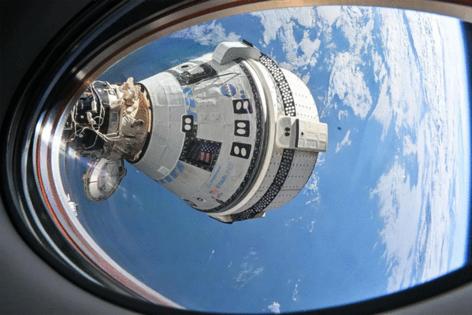Amid Musk threat to decommission SpaceX Dragon, NASA reveals more Boeing Starliner delays
Published in News & Features
As the fracas between Elon Musk and President Donald Trump escalated last week to the point of Musk threatening to decommission SpaceX’s Dragon spacecraft, NASA revealed even more delays to Dragon’s alternative, Boeing’s Starliner.
“NASA is assessing the earliest potential for a Starliner flight to the International Space Station in early 2026, pending system certification and resolution of Starliner’s technical issues,” according to a statement sent to media late Friday.
Though it didn’t mention SpaceX specifically, the statement — coupled with Musk’s threat — underscored the extraordinary degree to which NASA remains dependent on the private company for many of its key endeavors. It came after the fallout between the two powerful men sparked in part by Musk’s opposition to Trump’s so-call “Big Beautiful Bill” that critics including Musk say would increase federal spending.
Trump posted a threat on his Truth Social platform last week saying, “The easiest way to save money in our Budget, Billions and Billions of Dollars, is to terminate Elon’s Governmental Subsidies and Contracts. I was always surprised that Biden didn’t do it!”
That would include NASA’s Commercial Crew Program contracts that rely on SpaceX as the lone U.S.-based option to safely fly astronauts to the International Space Station.
“In light of the President’s statement about cancellation of my government contracts, @SpaceX will begin decommissioning its Dragon spacecraft immediately,” Musk posted to X in retort, although he later backed off.
By now, Boeing’s Starliner was supposed to have been a viable alternative sharing the taxi duties with SpaceX, but it has fallen behind Musk’s company by more than five years.
Last year, Starliner made its first flight with crew on board to the station, but suffered thruster issues and helium leaks on the way to docking with the station. NASA elected to send the spacecraft home without its crew, and the original plan for as short as an eight-day stay on board turned into more than nine months.
While Starliner was able to make a safe landing, NASA and Boeing’s path forward required not only a fix of the thruster and helium leak issues, but juggling whether or not the next flight would risk humans on board. That decision is pending, NASA said Friday.
“The agency is still evaluating whether Starliner’s next flight will be in a crew or cargo configuration,” NASA stated. “NASA astronauts are training for a Starliner post-certification mission as the agency continues to review its forward plans and execute testing campaigns targeted throughout the spring and summer.”
With the continued delay, two of the crew that were looking to fly on the first operational rotational crew mission — Starliner-1 — were pulled and reassigned to the upcoming SpaceX Crew-11 mission that’s targeting liftoff in late July.
NASA said it has not yet determined just who will be assigned to the full Starliner-1 crew.
But if the next flight is yet another uncrewed certification mission to ensure it’s safe for astronauts, and that doesn’t come until early 2026, then an actual operational flight would come likely no earlier than summer 2026.
In the meantime, SpaceX will be relied on to continue rotational missions, although for now NASA has not announced the mission that will relieve Crew-11.
If SpaceX were not a viable option, the U.S. would have to return to relying on Russia and its Soyuz spacecraft to maintain a presence on the space station. That’s the situation NASA was in after the Space Shuttle Program ended in 2011.
It wasn’t until May 2020 when SpaceX was successful with the crewed Demo-2 mission that NASA was able to launch from the U.S. again.
Since then, SpaceX has flown its fleet of four Crew Dragons 17 times carrying 64 humans to space. That includes 10 operational crew rotation missions as well as three private company visits to the space station for Axiom Space. A fifth Crew Dragon is set to launch for the first time Wednesday morning on Axiom Space’s Ax-4 mission taking another four-person crew on a two-week trip to the space station.
_____
©2025 Orlando Sentinel. Visit at orlandosentinel.com. Distributed by Tribune Content Agency, LLC.







Comments